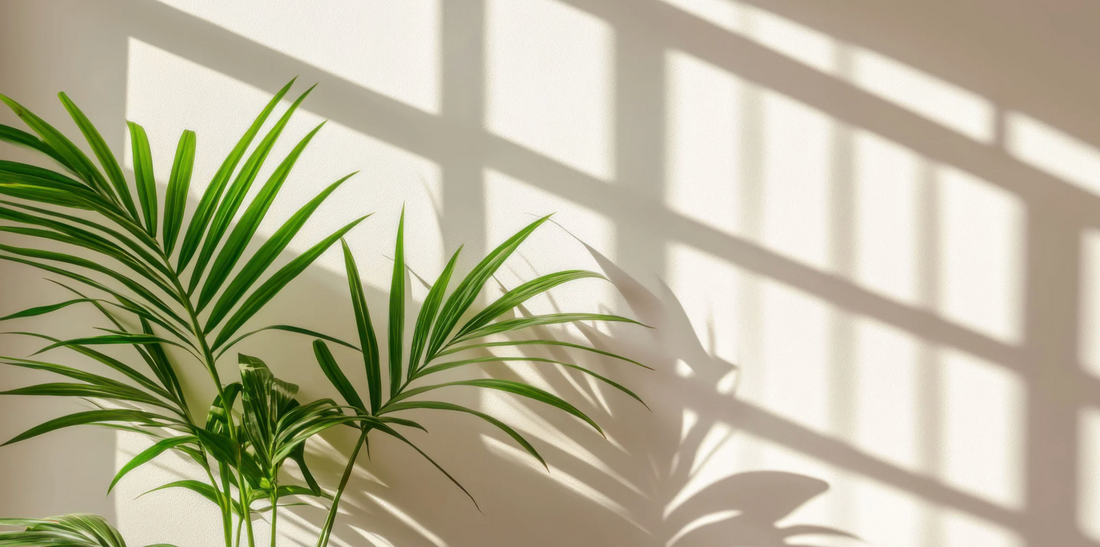Why “low light” is confusing
“Low light” doesn’t mean no light. Houseplants still need usable daylight to photosynthesize—just less of it than sun-lovers. University of Minnesota Extension classifies low light at roughly 50–250 foot-candles (≈ 500–2,500 lux) and notes these plants are typically understory species that tolerate dimmer spots like north windows or rooms set back from a window.
Quick context: Insufficient light slows growth, reduces flowering, and causes stretching (leggy stems). When light is truly inadequate for the plant, reserves deplete and the plant declines.
Easy ways to gauge light at home
-
Use a light meter or phone app to check lux/foot-candles at plant height—no fancy gear needed. UF/IFAS recommends simple, affordable meters or phone apps for household checks.
-
“Shadow test” heuristic: a soft/fuzzy shadow suggests indirect/medium light; a barely visible shadow suggests low light. (Helpful as a quick check—but note some horticulture educators caution it’s not precise under certain artificial lights, which can cast hard shadows even when overall intensity is low.)
What low light is not
-
A windowless room or closed-blinds corner (that’s no light—use a grow light).
-
Ideal for fast growth or reliable blooming; most plants will grow more slowly in low light.
The best low-light houseplants (that actually cope)
These species are widely recommended by university extensions for low-light conditions. They’ll grow more slowly than in brighter spots, but remain healthy with proper care:
-
ZZ plant (Zamioculcas zamiifolia) — storage rhizomes = drought tolerance; allow soil to dry.
-
Snake plant (Dracaena trifasciata, formerly Sansevieria) — architectural and forgiving; let mix dry between waterings.
-
Pothos (Epipremnum aureum) — tolerates low light; variegation may fade.
-
Heartleaf philodendron (Philodendron hederaceum) — classic trailer for dim rooms.
-
Aglaonema (Chinese evergreen) — many cultivars manage dim conditions well.
-
Parlor palm (Chamaedorea elegans) — gentle palm for soft light.
-
Peace lily (Spathiphyllum) — tolerates low light; blooms better with medium light.
-
Dracaena (several species) — upright, sculptural foliage for interior zones.
Pet safety note: Several popular low-light plants (e.g., pothos, philodendron, peace lily) are toxic to pets if chewed. Check with your vet for specifics.
How to set low-light plants up for success
1) Water less often (but more precisely).
In low light, soil dries more slowly; overwatering is the #1 issue. Let the top 2–5 cm dry for most species before watering again (UMN notes low-light plants use water more slowly).
2) Use a well-draining mix + drainage hole.
Low light + heavy soil = oxygen-starved roots. Choose a blend with some perlite/chunk for airflow (university guides emphasize matching plant needs to prevent root issues). Try out favorite Maya growing mediums or Molly's Mix
3) Rotate monthly & dust leaves.
Keeping leaves clean improves light capture; rotating evens growth toward windows.
4) Consider a discreet grow light in winter.
Short, dim winter days in Alberta? A small LED placed 30–60 cm above foliage for ~12–14 h can help—UMN outlines typical photoperiods for foliage houseplants (12–14 h).
How much light is “low”? (numbers for the curious)
-
Low light: about 50–250 foot-candles (≈500–2,500 lux).
-
Medium: ~250–1,000 foot-candles.
These ranges are consistent with multiple extension guides (UMN; MU/Arkansas references for foot-candle ranges).
Common low-light mistakes (and easy fixes)
-
“It stopped growing.”
Normal in low light—growth slows. Prioritize health (roots/leaves) over speed. -
“Leaves are pale or leggy.”
That’s insufficient light; move closer to a window or add a grow light. -
“I keep a lamp on—why isn’t that enough?”
Many household lamps don’t deliver plant-useful intensity/spectrum; use an LED grow bulb and place it close.
Starter layouts for real homes
-
North-facing living room: Snake plant grouping by the sofa; pothos 2–3 m from the window.
-
Office desk away from windows: Aglaonema + compact LED on a timer (12–14 h).
-
Hallway nook: ZZ on a stand; parlor palm floor-level—rotate monthly.
Want the deep dive on light?
If “low, medium, bright indirect” still feels murky, you’re not alone. We’ve got a separate Houseplant Lighting Guide(windows, seasons, PPFD vs. lux, distance, and placement) for a full breakdown—linked from our blog.
Shop & get advice
Visit Urbane Eight online. Tell us about your space—we’ll match you with plants that truly tolerate low light (and set you up with the right soil, stakes, and care tips).




